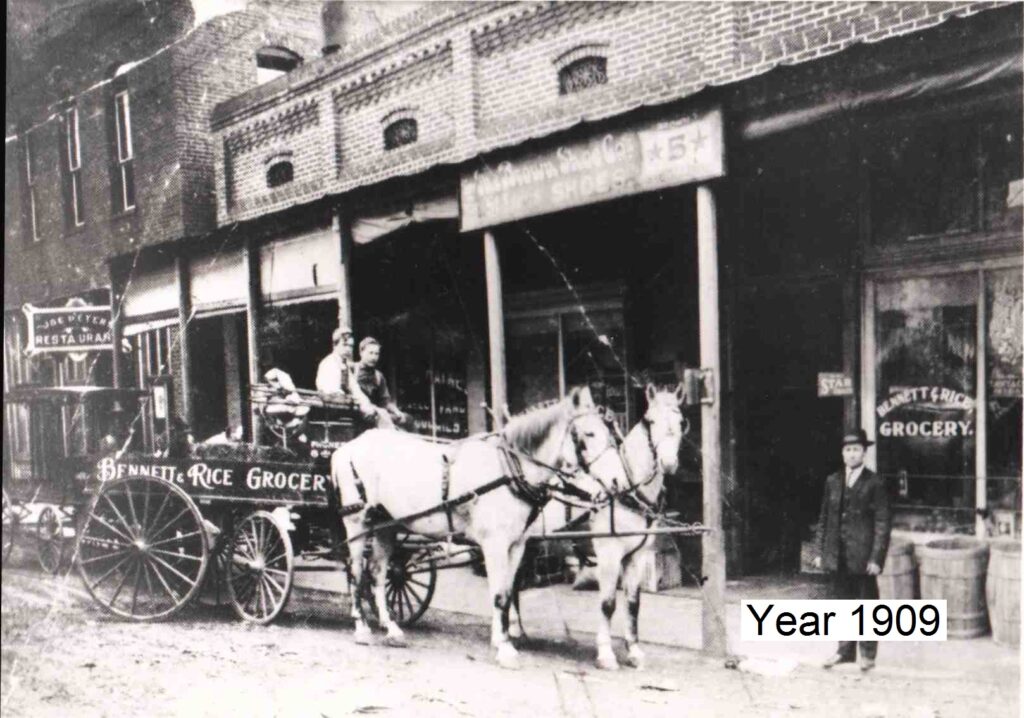History of the Lesmeister Building

First: How do you pronounce “Lesmeister”? We could be cute and say the way to pronounce Lesmeister is “a really nice place to stay”. But this subject must be taken seriously since we’re asked at least once a week how to pronounce this old family name that died out in our county over a hundred years ago.
Heinrich “Henry” Lesmeister built the building that now houses Lesmeister Guesthouse, and he’d appreciate knowing his name is being pronounced properly to this day, so it’s:
LESS as in less, rather than more, and with emphasis on this syllable.
my as in mine rather than yours.
stir as in the process James Bond prefers that you not use to agitate his martini.
LESS-my-stir
The land upon which Lesmeister Guesthouse stands was purchased February 24, 1902, by Henry Lesmeister, who proceeded to construct the building. Electricity didn’t come to Pocahontas until 1911, so Lesmeister’s building was originally lit only by its large east- and west-facing windows, and oil lamps. The streets in downtown Pocahontas were first paved in 1928. The land for the building was purchased from a larger plot of property in downtown Pocahontas that was purchased from Minnie Beauvais by Carl J. Roellin, June 4, 1894.
Henry* Lesmeister and his wife Martha Whipperman Lesmeister had immigrated to America from Essen, Germany, first settling in Lexington, Kentucky, before moving in 1880 to Pocahontas with their son, Henry Jr. and their daughter Theresa Frances.
*Lesmeister’s given name, in the Germany of his birth, was Heinrich, but they apparently anglicized it to Henry when he immigrated to America.
Henry Jr. became a noted architect who designed the grandest buildings in downtown Pocahontas, including his father’s building that now houses Lesmeister Guesthouse. Henry Jr. also designed the roof on St. Paul the Apostle Catholic Church in Pocahontas, with its king trusses that carry the building’s roof without need for interior support posts. Henry Jr. also designed many buildings in nearby Jonesboro and as far away as Memphis, Tennessee.
With time, young Theresa Frances Lesmeister became the bride of Hubert A. Peters, whose family had come to America from Aachen, Germany, settling first in Columbus, Ohio, before moving to Pocahontas in 1880.
Initially, Peters opened Peters Grocery in the north half of the Lesmeister building, with Bennett and Rice Grocery opening soon after that in the south half of the building. Peters Grocery sold “everything from thread to harnesses”.

The Peters Grocery soon needed space to expand and Peters, along with his business partner Ferdinand Spinnenweber, Sr., built and moved to a larger building facing the Pocahontas town square. That building now houses the Randolph County Heritage Museum. The Blissenbach Furniture Store later opened in north half of the Lesmeister building where the Peters Grocery had been previously.
In 1925 the building became the property of Mr. Lesmeister’s daughter, Theresa, and her children, the Peters family. In 1945 one of Hubert and Theresa Peters’ daughters, Mary Martha Peters Burke, purchased the building from her siblings. Upon Mrs. Burke’s death the building passed on to her daughter, Mary Frances Burke Brackett. The building was owned by Lesmeister and his descendants for over 100 years. During this time the building housed numerous businesses, including a jewelry store, a furniture store, and in later years a pool hall and entertainment center.
The old building finally sat vacant for a few years before Pocahontas native, Dr. Patrick Carroll, purchased the property in February, 2011, to restore it to its 1902 outside appearance as it became the Lesmeister Guesthouse, featuring two vacation rental apartments and three suites, with interior decor and fixtures reminiscent of the 1902 era while offering modern comforts.

There’s an interesting story regarding the man identified as “Uncle Frank” in the photo above. Mary Frances Burke Brackett, whose mother Mary Martha is in the photo above, explained, “Uncle Frank really was not a family member. In the 1890’s he appeared at the Peters’ back door and asked if there was work he could do in return for food. Grandmother (Mrs. Theresa Peters) fed him well and said he could chop a little kindling in return. Being a cold late afternoon he asked if he could spend the night someplace. Then, with my grandfather’s permission, he spent the night in the laundry house. When the family awoke the next morning there were warm fires built in all the stoves and coffee brewing on the kitchen stove. He then moved into the family home and remained there until his death in 1916. He helped with the children, did gardening, and few questions were asked about his past. It was assumed because of his education and mannerisms that he was of noble birth and possibly a deserter from the Austrian Army. He was always referred to as “Uncle Frank”, the man who came to dinner.”

Information in this report comes from the deed records of the Randolph County Circuit Clerk (Book 27, Page 360; Book 28, Page 254; and Book 59, Page 491), the book “1910 Directory of Randolph County” by L. F. Blankenship, and the book “The Making of Catholic Hill” by Susan Moore Thielemier.
